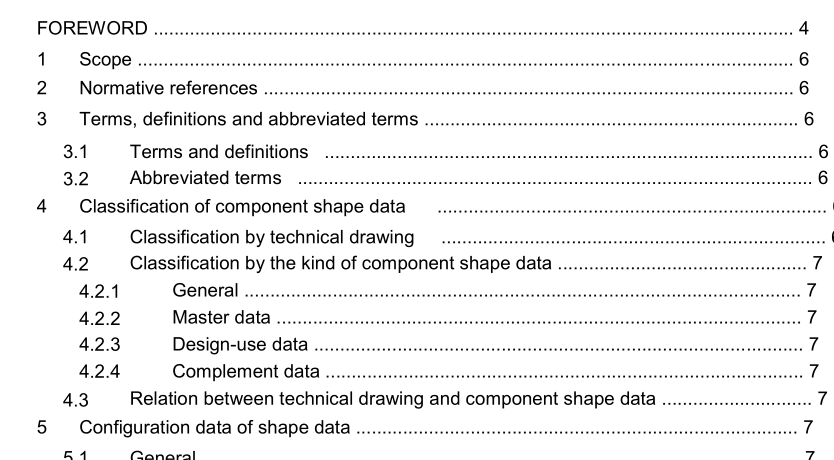IEC TR 61188-8-2021 pdf Circuit boards and circuit board assemblies – Design and use – Part 8: 3D shape data for CAD component library

5.6 Reference point and placement angle Rules for 2D drawings 5.6.1 The rules for 2D drawings are as follows: a) components and land patterns are drawn in top view; b) the component point of origin is shown by “+” or “x”; c) A circumscribing rectangle which contains the component body and land patterns (in top view) should be a part of the library component description. This rectangle is the “Courtyard” that provides a minimum electrical and physical clearance for the part and the land pattern. The point of origin of the description should match that of the component and land pattern. The descriptions of the components, land patterns, and circumscribed rectangles, described are the same in the computer library, and each description uses the same origin coordinates. It is recommended that the point of origin is the same as the way the component is positioned on the final design of the board which is normally by the centroid of the component body. 5.6.2 Rules for 3D shape models (component with no moving part) The rules for 3D shape models (component with no moving part) described are as follows: a) relation between 2D drawing and 3D shape model; It is desirable to design the reference point and placement angle according to the same rules. b) reference point; The center of the outline of the largest rectangle containing the electrodes described are the reference point. The sitting plane is considered to have a Z value of 0, and the direction moving below the seating plane is considered the minus direction of the Z-axis. c) placement angle Indicate the polarity so that it is in the minus direction in the X-axis or in the minus directions of both X- and Y-axes. The example of placement angle is shown in Figure 2.
- ISO IEC 27050-4-2021 pdf Information technology — Electronic discovery — Part 4: Technical readiness
- ISO IEC 27036-1-2021 pdf Cybersecurity — Supplier relationships — Part 1: Overview and concepts
- ISO IEC 27013-2021 pdf Information security, cybersecurity and privacy protection — Guidance on the integrated implementation of ISO/IEC 27001 and ISO/IEC 20000-1
- ISO IEC 26580-2021 pdf Software and systems engineering — Methods and tools for the feature- based approach to software and systems product line engineering
- ISO IEC 24735-2021 pdf Information technology — Office equipment — Method for measuring digital copying productivity
- ISO IEC 24711-2021 pdf Information technology — Office equipment — Method for the determination of ink cartridge yield for colour inkjet printers and multi- function devices that contain printer components
- ISO IEC 23544-2021 pdf Information Technology — Data centres — Application Platform Energy Effectiveness (APEE)
- ISO IEC 23510-2021 pdf Information technology — 3D printing and scanning — Framework for an Additive Manufacturing Service Platform (AMSP)
- ISO IEC 23127-1-2021 pdf Information technology — Learning, education, and training — Metadata for facilitators of online learning — Part 1: Framework
- ISO IEC 23126-2021 pdf Information technology for learning, education and training — Ubiquitous learning resource organization and description framework
- ISO IEC 27041-2013 pdf Information technology – Security Guidance on assuring suitability and adequacy of incident investigative methods
- IEC TR 62834-2013 pdf IEC nanoelectronics standardization roadmap
- IEC TR 61188-8-2021 pdf Circuit boards and circuit board assemblies – Design and use – Part 8: 3D shape data for CAD component library
- IEC 62282-7-2-2021 pdf Fuel cell technologies – Part 7-2: Test methods – Single cell and stack performance tests for solid oxide fuel cells (SOFCs)
- IEC 61453-2007 pdf Nuclear instrumentation – Scintillation gamma ray detector systems for the assay of radionuclides – Calibration and routine tests
- BS ISO IEC 15420-2009 pdf Information technology一 Automatic identification and data capture techniques EAN/UPC bar code symbology specification
- BS IEC 60860-2014 pdf Radiation protection instrumentation一 Warning equipment for criticality accidents
- BS ISO IEC 19762.5-2008 pdf Information technology一 Automatic identification and data capture (AIDC) techniques – Harmonized vocabulary Part 5: Locating systems
- ISO IEC 24735-2021 pdf Information technology — Office equipment — Method for measuring digital copying productivity
- ISO IEC 24711-2021 pdf Information technology — Office equipment — Method for the determination of ink cartridge yield for colour inkjet printers and multi- function devices that contain printer components